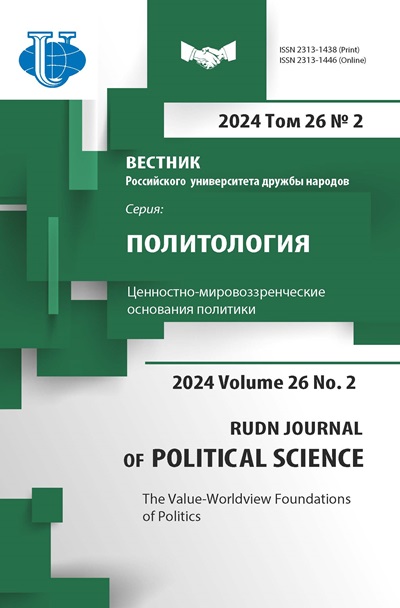East Asia at the Crossroads of Cooperation and Rivalry at the Regional and International Levels: Editorial Introduction
- Authors: Kuteleva A.V.1, Shcherbakov D.A.1
-
Affiliations:
- National Research University Higher School of Economics
- Issue: Vol 23, No 2 (2021): East Asia at the Crossroads of Cooperation and Rivalry at the Regional and International Levels
- Pages: 207-214
- Section: ARTICLES and REVIEWS
- URL: https://journals.rudn.ru/political-science/article/view/26539
- DOI: https://doi.org/10.22363/2313-1438-2021-23-2-207-214
Cite item
Full Text
Abstract
The rise of new powers throughout the 2000s and the 2010s augurs the end of the unipolar system that has persisted since the end of the Cold War. In no region is this transition more compelling than in East Asia. Economic revitalization of this region and a steady redistribution of power related to it is a dynamic process characterized by intense changes in foreign policy strategies, practices, and orientations of China, Korea, and Japan. The proposed special issue seeks to critically assess the emerging developments of China’s, Japan’s, and Korea’s core international perceptions and policies. More specifically, the special issue addresses two complex and interrelated questions. Firstly, how do China, Korea, and Japan adapt to the changing international landscape? Secondly, how do China, Korea, and Japan respond to the challenges inherent to the pursuit of the enhanced international status? The contributions to this special issue aim at scrutinizing China’s cybersovereignty and industrial policy; exploring the strengths and limitations of Korea’s public diplomacy; and examining Japan’s contributions to regionalism. The special issue also discusses Russia’s relations with East Asia and its role in regional politics.
Keywords
About the authors
Anna V. Kuteleva
National Research University Higher School of Economics
Author for correspondence.
Email: akuteleva@hse.ru
ORCID iD: 0000-0001-7805-1607
PhD in Political Science, Research Fellow, Faculty of World Economy and International Affairs
Moscow, Russian FederationDenis A. Shcherbakov
National Research University Higher School of Economics
Email: dshcherbakov@hse.ru
ORCID iD: 0000-0001-8607-6265
PhD in Economics, director of the Centre for International Cooperation, Associate Professor of the School of Asian Studies, Faculty of World Economy and International Affairs
Moscow, Russian FederationReferences
- Gill, B. (2020). China’s global influence: Post-COVID prospects for soft power. The Washington Quarterly, 43(2), 97–115. doi: 10.1080/0163660X.2020.1771041
- Ikenberry, G. J., & Mastanduno, M. (Eds.). (2003). International relations theory and the AsiaPacific. Columbia University Press.
- Joo, J. (2011). Transnationalization of Korean popular culture and the rise of “pop nationalism” in Korea. The Journal of Popular Culture, 44(3), 489–504. doi: 10.1111/j.1540-5931.2011.00845.x
- Karaganov, S., & Bordachev, T. (Eds.). (2019) Toward the Great Ocean: A сhronicle of Russia’s turn to the East. Moscow, Boslen publ. (In Russian).
- Khong, Y. F. (2018). A regional perspective on the US and Chinese visions for East Asia. Asia Policy, 25(2), 6–12.
- Khudoley, K., (2018). Korean Peninsula: Steps from the Abyss. Rossiya v global’noi politike, 16(6), 204–214. URL: https://globalaffairs.ru/articles/korejskij-poluostrov-shagi-ot-propasti/> (Accessed on 1 March 2021). (In Russian).
- Klare, M. T. (1993). The next great arms race. Foreign Affairs, 72(3), 136–152.
- Koga, K. (2017). The concept of “hedging” revisited: The case of Japan’s foreign policy strategy in East Asia’s power shift. International Studies Review, 20(4), 633–660. doi: 10.1093/isr/vix059
- Kristof, N. D. (1998). The problem of memory. Foreign Affairs, 77(1), 37–49.
- Liu, W., Dunford, M., & Gao, B. (2018). A discursive construction of the Belt and Road Initiative: From neo-liberal to inclusive globalization. Journal of Geographical Sciences, 28(9), 1199–1214. doi: 10.1007/s11442-018-1520-y
- Lukin, A. V. (2019). Discussion on the development of China and the prospects for its foreign policy. Polis: Journal of Political Studies, (1), 71–89. doi: 10.17976/jpps/2019.01.06. (In Russian).
- Sørensen, C. T. (2015). The significance of Xi Jinping’s “Chinese Dream” for Chinese foreign policy: From “Tao Guang Yang Hui” to “Fen Fa You Wei”. Journal of China and International Relations, 3(1), 53–73. doi: 10.5278/ojs.jcir.v3i1.1146
















